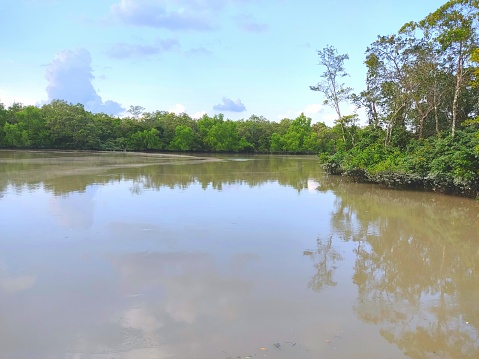On their Sundarban Package tour, clients and travellers often ask us – How sundarbans got their name: and the answer is quite a satisfying one.
The Sundarbans, a vast mangrove forest located in the delta of the Ganges, Brahmaputra, and Meghna rivers in Bangladesh and India, is known for its unique ecosystem and biodiversity, including the Bengal tiger. But have you ever wondered how this lush forest got its name?
So this blog will be all about that – let’s get straight to it.
How did Sundarban get its name?
The name Sundarbans is believed to have originated from the Bengali word “sundari,” which refers to the abundant mangrove trees (Heritiera fomes) found in the region.
The word “sundarbans” is derived from the Bengali words “sundar” meaning “beautiful” and “ban” meaning “forest. These large trees are abundant in the Sundarbans, hence giving the area its name. The name Sundarbans translates to “beautiful forest” in Bengali, emphasizing the lush and thriving nature of the region.
This refers to the lush and beautiful forests that once covered the region. In the past, the sundarbans was considered a land of wealth and prosperity, where abundant resources such as honey, timber, and fish could be found. The name is a testament to the once thriving and flourishing nature of the region.
The mangrove forests, tidal creeks, and mudflats of the Sundarbans make up a unique ecosystem that supports a rich diversity of flora and fauna, including the Bengal tiger. Despite the challenges posed by human activities such as deforestation, fishing, and shrimp farming, conservation efforts are being made to protect this valuable and irreplaceable ecosystem.
The sundarbans is also known for its unique mangrove forests, which have a high level of salinity and provide a habitat for various species of birds, fish, and reptiles. The mangroves, along with the tidal creeks and mudflats, make up the complex system of intertidal habitats in the sundarbans that support its diverse flora and fauna.
Inspite of all this, the mobile network in sundarbans is actually better than what you’d expect. Crazy, right?
In 1997, the sundarbans was declared a UNESCO World Heritage Site for its unique biodiversity and conservation value. Today, the sundarbans is under threat due to increasing human activity, such as deforestation, fishing, and the construction of shrimp farms, which have put pressure on the delicate ecosystem. Efforts are underway to conserve the sundarbans and its unique biodiversity, including the Bengal tiger, which is an important part of the forest’s ecosystem.
Want to visit Sundarbans?
Go through our unique and famous sundarban packages that you’d surely enjoy:
- Sundarban Package Tour
- Sundarban Luxury Tour Package
- Sundarban Tour Package From Kolkata (Check the guide on how to reach sundarbans here)
- Sundarban Tour Package From Canning
- Sundarban Tour for Couples
- Sundarban Day Tour
- Sundarban Tour 1 Night 2 Days
- Sundarban Tour 2 Night 3 Days
Want to Know more on Rates? Checkout our blog on how much does a sundarban trip costs (HINT: Extremely Pocket Friendly :D).
In conclusion, the sundarbans got its name from the beautiful and lush forests that once covered the region. Today, the sundarbans continues to be a vital and unique ecosystem, providing habitat to a variety of flora and fauna, including the Bengal tiger. Despite the challenges, efforts are underway to conserve this precious ecosystem for future generations.






